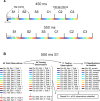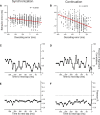The Computational and Neural Basis of Rhythmic Timing in Medial Premotor Cortex
- PMID: 28336572
- PMCID: PMC6596663
- DOI: 10.1523/JNEUROSCI.0367-17.2017
The Computational and Neural Basis of Rhythmic Timing in Medial Premotor Cortex
Abstract
The neural underpinnings of rhythmic behavior, including music and dance, have been studied using the synchronization-continuation task (SCT), where subjects initially tap in synchrony with an isochronous metronome and then keep tapping at a similar rate via an internal beat mechanism. Here, we provide behavioral and neural evidence that supports a resetting drift-diffusion model (DDM) during SCT. Behaviorally, we show the model replicates the linear relation between the mean and standard-deviation of the intervals produced by monkeys in SCT. We then show that neural populations in the medial premotor cortex (MPC) contain an accurate trial-by-trial representation of elapsed-time between taps. Interestingly, the autocorrelation structure of the elapsed-time representation is consistent with a DDM. These results indicate that MPC has an orderly representation of time with features characteristic of concatenated DDMs and that this population signal can be used to orchestrate the rhythmic structure of the internally timed elements of SCT.SIGNIFICANCE STATEMENT The present study used behavioral data, ensemble recordings from medial premotor cortex (MPC) in macaque monkeys, and computational modeling, to establish evidence in favor of a class of drift-diffusion models of rhythmic timing during a synchronization-continuation tapping task (SCT). The linear relation between the mean and standard-deviation of the intervals produced by monkeys in SCT is replicated by the model. Populations of MPC cells faithfully represent the elapsed time between taps, and there is significant trial-by-trial relation between decoded times and the timing behavior of the monkeys. Notably, the neural decoding properties, including its autocorrelation structure are consistent with a set of drift-diffusion models that are arranged sequentially and that are resetting in each SCT tap.
Keywords: drift-diffusion model; ensemble recordings; monkey; supplementary motor cortex; timing.
Copyright © 2017 the authors 0270-6474/17/374552-13$15.00/0.
Figures











Comment in
-
The Medial Premotor Cortex as a Bridge from Internal Timekeeping to Action.J Neurosci. 2017 Sep 13;37(37):8860-8862. doi: 10.1523/JNEUROSCI.1790-17.2017. J Neurosci. 2017. PMID: 28904213 Free PMC article. No abstract available.
Similar articles
-
Neurophysiology of timing in the hundreds of milliseconds: multiple layers of neuronal clocks in the medial premotor areas.Adv Exp Med Biol. 2014;829:143-54. doi: 10.1007/978-1-4939-1782-2_8. Adv Exp Med Biol. 2014. PMID: 25358709 Review.
-
Dynamic representation of the temporal and sequential structure of rhythmic movements in the primate medial premotor cortex.J Neurosci. 2014 Sep 3;34(36):11972-83. doi: 10.1523/JNEUROSCI.2177-14.2014. J Neurosci. 2014. PMID: 25186744 Free PMC article.
-
Diverse Time Encoding Strategies Within the Medial Premotor Areas of the Primate.Adv Exp Med Biol. 2024;1455:117-140. doi: 10.1007/978-3-031-60183-5_7. Adv Exp Med Biol. 2024. PMID: 38918349 Review.
-
Measuring time with different neural chronometers during a synchronization-continuation task.Proc Natl Acad Sci U S A. 2011 Dec 6;108(49):19784-9. doi: 10.1073/pnas.1112933108. Epub 2011 Nov 21. Proc Natl Acad Sci U S A. 2011. PMID: 22106292 Free PMC article.
-
Sensorimotor neural dynamics during isochronous tapping in the medial premotor cortex of the macaque.Eur J Neurosci. 2015 Mar;41(5):586-602. doi: 10.1111/ejn.12811. Eur J Neurosci. 2015. PMID: 25728178
Cited by
-
Influence of Recent Trial History on Interval Timing.Neurosci Bull. 2023 Apr;39(4):559-575. doi: 10.1007/s12264-022-00954-2. Epub 2022 Oct 8. Neurosci Bull. 2023. PMID: 36209314 Free PMC article.
-
A Second Introduction to the Neurobiology of Interval Timing.Adv Exp Med Biol. 2024;1455:3-23. doi: 10.1007/978-3-031-60183-5_1. Adv Exp Med Biol. 2024. PMID: 38918343 Review.
-
Measuring self-similarity in empirical signals to understand musical beat perception.Eur J Neurosci. 2025 Jan;61(2):e16637. doi: 10.1111/ejn.16637. Eur J Neurosci. 2025. PMID: 39853878 Free PMC article.
-
White matter structural bases for phase accuracy during tapping synchronization.Elife. 2024 Sep 4;13:e83838. doi: 10.7554/eLife.83838. Elife. 2024. PMID: 39230417 Free PMC article.
-
Internally generated time in the rodent hippocampus is logarithmically compressed.Elife. 2022 Oct 17;11:e75353. doi: 10.7554/eLife.75353. Elife. 2022. PMID: 36250631 Free PMC article.
References
-
- Gibbon J. (1977) Scalar expectancy theory and Weber's law in animal timing. Psychol Rev 84:279–325. 10.1037/0033-295X.84.3.279 - DOI
Publication types
MeSH terms
LinkOut - more resources
Full Text Sources
Other Literature Sources
Miscellaneous
